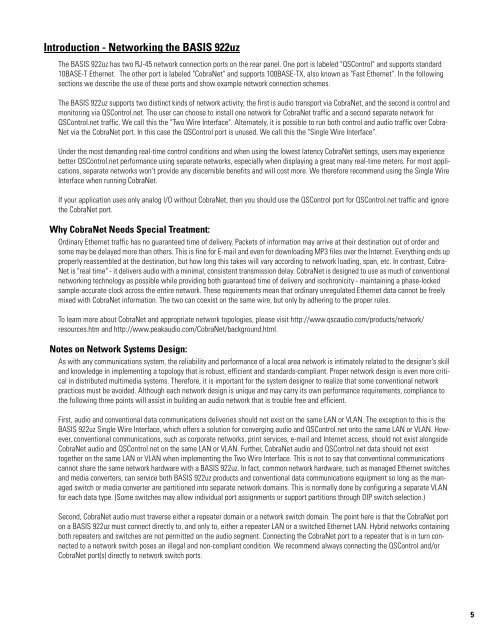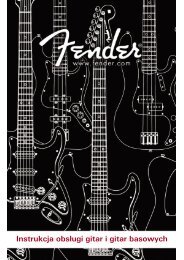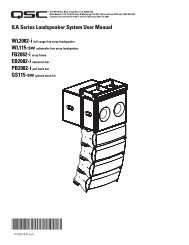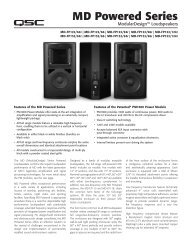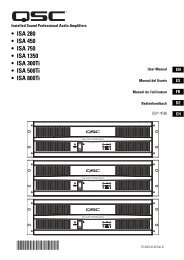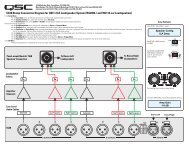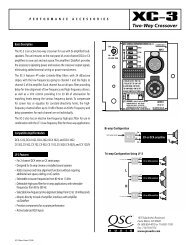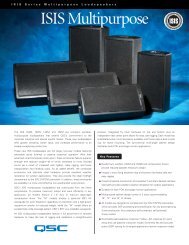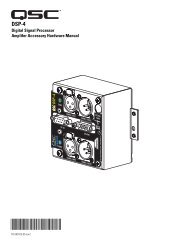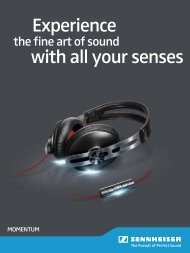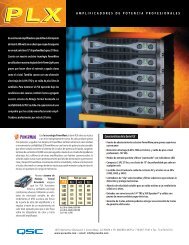Create successful ePaper yourself
Turn your PDF publications into a flip-book with our unique Google optimized e-Paper software.
Introduction - Networking the <strong>BASIS</strong> <strong>922uz</strong><br />
The <strong>BASIS</strong> <strong>922uz</strong> has two RJ-45 network connection ports on the rear panel. One port is labeled "<strong>QSC</strong>ontrol" and supports standard<br />
10BASE-T Ethernet. The other port is labeled "CobraNet" and supports 100BASE-TX, also known as "Fast Ethernet". In the following<br />
sections we describe the use of these ports and show example network connection schemes.<br />
The <strong>BASIS</strong> <strong>922uz</strong> supports two distinct kinds of network activity; the first is audio transport via CobraNet, and the second is control and<br />
monitoring via <strong>QSC</strong>ontrol.net. The user can choose to install one network for CobraNet traffic and a second separate network for<br />
<strong>QSC</strong>ontrol.net traffic. We call this the "Two Wire Interface". Alternately, it is possible to run both control and audio traffic over Cobra-<br />
Net via the CobraNet port. In this case the <strong>QSC</strong>ontrol port is unused. We call this the "Single Wire Interface".<br />
Under the most demanding real-time control conditions and when using the lowest latency CobraNet settings, users may experience<br />
better <strong>QSC</strong>ontrol.net performance using separate networks, especially when displaying a great many real-time meters. For most applications,<br />
separate networks won't provide any discernible benefits and will cost more. We therefore recommend using the Single Wire<br />
Interface when running CobraNet.<br />
If your application uses only analog I/O without CobraNet, then you should use the <strong>QSC</strong>ontrol port for <strong>QSC</strong>ontrol.net traffic and ignore<br />
the CobraNet port.<br />
Why CobraNet Needs Special Treatment:<br />
Ordinary Ethernet traffic has no guaranteed time of delivery. Packets of information may arrive at their destination out of order and<br />
some may be delayed more than others. This is fine for E-mail and even for downloading MP3 files over the Internet. Everything ends up<br />
properly reassembled at the destination, but how long this takes will vary according to network loading, span, etc. In contrast, Cobra-<br />
Net is "real time" - it delivers audio with a minimal, consistent transmission delay. CobraNet is designed to use as much of conventional<br />
networking technology as possible while providing both guaranteed time of delivery and isochronicity - maintaining a phase-locked<br />
sample-accurate clock across the entire network. These requirements mean that ordinary unregulated Ethernet data cannot be freely<br />
mixed with CobraNet information. The two can coexist on the same wire, but only by adhering to the proper rules.<br />
To learn more about CobraNet and appropriate network topologies, please visit http://www.qscaudio.com/products/network/<br />
resources.htm and http://www.peakaudio.com/CobraNet/background.html.<br />
Notes on Network Systems Design:<br />
As with any communications system, the reliability and performance of a local area network is intimately related to the designer's skill<br />
and knowledge in implementing a topology that is robust, efficient and standards-compliant. Proper network design is even more critical<br />
in distributed multimedia systems. Therefore, it is important for the system designer to realize that some conventional network<br />
practices must be avoided. Although each network design is unique and may carry its own performance requirements, compliance to<br />
the following three points will assist in building an audio network that is trouble free and efficient.<br />
First, audio and conventional data communications deliveries should not exist on the same LAN or VLAN. The exception to this is the<br />
<strong>BASIS</strong> <strong>922uz</strong> Single Wire Interface, which offers a solution for converging audio and <strong>QSC</strong>ontrol.net onto the same LAN or VLAN. However,<br />
conventional communications, such as corporate networks, print services, e-mail and Internet access, should not exist alongside<br />
CobraNet audio and <strong>QSC</strong>ontrol.net on the same LAN or VLAN. Further, CobraNet audio and <strong>QSC</strong>ontrol.net data should not exist<br />
together on the same LAN or VLAN when implementing the Two Wire Interface. This is not to say that conventional communications<br />
cannot share the same network hardware with a <strong>BASIS</strong> <strong>922uz</strong>. In fact, common network hardware, such as managed Ethernet switches<br />
and media converters, can service both <strong>BASIS</strong> <strong>922uz</strong> products and conventional data communications equipment so long as the managed<br />
switch or media converter are partitioned into separate network domains. This is normally done by configuring a separate VLAN<br />
for each data type. (Some switches may allow individual port assignments or support partitions through DIP switch selection.)<br />
Second, CobraNet audio must traverse either a repeater domain or a network switch domain. The point here is that the CobraNet port<br />
on a <strong>BASIS</strong> <strong>922uz</strong> must connect directly to, and only to, either a repeater LAN or a switched Ethernet LAN. Hybrid networks containing<br />
both repeaters and switches are not permitted on the audio segment. Connecting the CobraNet port to a repeater that is in turn connected<br />
to a network switch poses an illegal and non-compliant condition. We recommend always connecting the <strong>QSC</strong>ontrol and/or<br />
CobraNet port(s) directly to network switch ports.<br />
5


